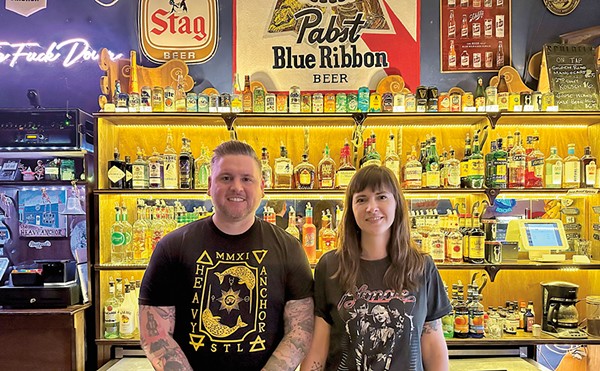Moreover, though Coltrane's later "free" playing lacks the finger-popping, head-nodding character of his early days, it is still a cornerstone of the jazz world, another analogy that transfers well to techno's increasingly strained relationship with clubland's dance floors. The rarefied aesthetes of the jazz world appreciating fine art is also a welcome image, one electronica's adherents much prefer to television news clips of drug-addled teens tripping over their baggy jeans.
Among techno's cognoscenti, jazz now stands as a source of inspiration and a way out of the creative cul-de-sac that so many metronomic beatmeisters have found themselves in.
"Jazz is a step -- not the step -- but a step out for people trying to warm up the whole electronic thing," says Carl Craig, one of America's pre-eminent techno producers. As proof, the Detroit-based Craig points to his latest album, Programmed (Planet E), recorded under the moniker Innerzone Orchestra, with percussionist Francisco Mora (an alumnus of the Sun Ra Arkestra), keyboardist Craig Taborn (who has performed with James Carter and the Art Ensemble of Chicago) and Matt Chicoine (who, as Recloose, constructs inventive, off-kilter electronica for Craig's own Planet E label). Programmed is the sum of those combined résumés, reflecting a vision steeped in the avant-garde jazz currents of the '70s as well as Detroit's seminal techno grooves, all the while seeking to transcend both.
"I'd hope that there are young cats out there who think they know what techno is," Craig continues, his voice taking on the tenor of a wary preacher, "and if they've got an open mind, they'll hear Programmed and say, "This is some interesting shit; this is new techno.' Then they'll listen to someone's jazz show on public radio, come across Miles Davis' Rated X or any of Miles' late '60s or '70s things, and be able to make a connection between that, Tortoise and Herbie Hancock's '70s stuff. Then they'll be able to help move the scene forward so it doesn't remain so sterile."
If concern for the scene seems strange coming from an artist who regularly jet-sets around the world to high-paying DJ gigs, it also reflects a position of prominence that has been thrust upon him whether he likes it or not. The 30-year-old Craig first emerged at the dawn of the '90s as a disciple of Derrick May, who (along with Juan Atkins and Kevin Saunderson) is widely credited with inventing techno, a fusion of sweaty funk and coolly hypnotic tempos that May described as "George Clinton and Kraftwerk meeting in an elevator."
By the mid-'90s, however, May's attention had shifted from releasing new records to DJ-ing (an aural absence that still endures). For their parts, Atkins and Saunderson delivered works that, though certainly solid, lacked the fire and revolutionary spirit of their youthful output. Likewise, the "second generation" of Detroit techno producers who came of age as Craig's contemporaries (such as Stacey Pullen and Claude Young) had become legendary more for their head-spinning DJ sets than for their own vinyl.
In contrast, Craig has spent the bulk of the decade hunkered down in his studio working on a slew of efforts, notable not just for their brilliance but for their continual theme of reinvention. As the Paperclip People, he created churning, sleazy dance-floor burners that gave a knowing nod to the glitter-ball days of Giorgio Moroder's disco. As Six Nine (his birth year), Craig fashioned twisting miniepics of soulful bump-and-grind; under his own name, he released the album More Songs about Food and Revolutionary Art. It's a record that exists as one of techno's few fully realized, self-contained works and coheres as just that: an album in the classic sense of the word, full of mournful peals erecting a sumptuous soundscape. Add in the 1992 Innerzone Orchestra single "Bug in the Bassbin" (often cited by British fans as one of that nation's templates for drum & bass), and you have a canon that establishes Craig as one of techno's international leading lights, an artist to whom electronica's doyens look for guidance regarding what their music is "supposed" to sound like.
So how does techno's crown sit on Craig's head? "It's been a plague for the last five years," he snaps. "When I started Planet E, the whole concept was to make music that would be classic, that was always expanding the boundaries." Despite this independent tone, Craig has felt public pressure to produce a "Carl Craig" sound, one that conforms to the approach of his past work. Accordingly, the jazz tinge of Programmed may throw some fans for a loop. "I know people are going to say, "What the hell is this? What's going on with Carl Craig?' But maybe in a year, maybe in five years, they'll come around and say, "Oh, I get it now. I had to get a little bit older; I had to hear differences in music throughout time.'"
Programmed isn't that radical, but it does include several sharp sonic veers for Craig; there's precious little delving into the butt-shaking rhythms that marked his past work. Instead we get a minimalist, largely acoustic cover of the Stylistics' "People Make the World Go Round" (seemingly included more to score philosophical points about Craig's interest in '70s soul than for the track's own merits); an eerily touching answering-machine message from a confused late-night lover; and a humorously bizarre skewering of hip-hop's structural conservatism. That song, "The Beginning of the End," features rapper Lacksi-Daisy-Cal tossing out paranoid premillennium quips while crunching on a mouthful of potato chips, taking time out to verbally spar with a double-tracked recording of himself. "I wanted it to be an antidote to the humdrum, the usual hip-hop shenanigans where you take a break and just rap on top of it," Craig explains. "There's so many things that people in hip-hop haven't touched on yet."
The meat of Programmed, though, is given over to extended vamps that recall the flow of Herbie Hancock's 1973 album Mwandishi or the Human Arts Ensemble's sprawling "outside" workouts from the same era. It's hard to shake a leg when listening to it, but a pleasant brain twitch is unavoidable. At its best, as on "Basic Math," the music slowly builds from tinkling drumplay to an insistent, probing, deep bass line. Thick washes of electric piano begin to move in, with gurgles of synthesized noise peeking through. Once the song grows in momentum, with Francisco Mora's drumming keeping things satisfyingly in the pocket, Craig leads the group into deep space, then back again.
And space certainly seems to be the destination of choice on Programmed, as Craig joins the ranks of black sci-fi futurists dreaming of life far beyond the urban terrain with its suffocating discourse on the possible. "Yeah, this album is different from what I usually do," Craig says. "It puts you in a disjointed frame of mind; everything's off a little bit. But why not ring out the 20th century on a crazy note instead of the same old rudimentary stuff?"
Carl Craig spins a DJ set somewhere in the region as part of the Superstars of Love's "Spooks in Space" party on Saturday, Oct. 30. Also spinning will be Sandra Collins, Nitro, DJ Bodaleg and Stan Doublin, among others. For specifics, call 994-1114.





